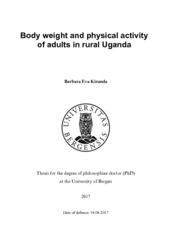| dc.description.abstract | Background: Overweight, obesity and physical inactivity are on the increase across the world. However, the general lack of evidence on overweight, obesity and physical inactivity and their correlates in Africa, suggests a need for research in sub-Saharan Africa so as to inform the development of effective population-based interventions for the physical activity (PA) promotion, and prevention of overweight, obesity and non-communicable diseases (NCDs). The objectives of the thesis were to assess the prevalence of overweight and/or obesity, physical inactivity and sedentary behaviour and their associated factors and assess the validity of the Global Physical Activity Questionnaire (GPAQ) among peri-urban and rural Ugandan adults. Methods: A population-based cross-sectional study of 1210 randomly selected adults was conducted in the Iganga-Mayuge Health and Demographic Surveillance Site, Uganda. Height, weight and socio-demographic variables were assessed. Physical activity was assessed by both a pedometer and the GPAQ for a seven-day period. Logistic regression was conducted to identify factors associated with overweight and/or obesity, physical inactivity and sedentary behaviour. Percent agreement scores and kappa statistics were computed and linear regression analysis was run. Results: Of the participants, 17.8 % were overweight (12.4 % of men; 23.1 % of women, p < 0.001); and 7 % were obese (2.0 % of men; 12.7 % of women, p < 0.001). Prevalence of overweight was 15.8 % and 23.8 % among rural and periurban adults, respectively (p < 0.001). Prevalence of obesity was 3.9 % and 17.8 % among rural and peri-urban adults, respectively (p < 0.001). Factors associated with overweight and or/obesity were: being female, (adjusted odds ratio (AOR) 4.3; 95 % confidence interval (CI) 3.2–5.9); peri-urban residence (AOR 2.6; 95 % CI 1.9–3.6); being in age groups 35–44 (AOR 3.1; 95 % CI 1.8– 5.3), 45–54 (AOR 4.1; 95 % CI 2.3–7.3), 55–64 (AOR 2.6; 95 % CI 1.4–5.0 and 65 years (AOR 3.1; 95 % CI 1.6–6.0); and having socio-economic status (SES) in the third (AOR 2.8; 95 % CI 1.7–4.6), fourth (AOR 2.5; 95 % CI 1.5– 4.2 and fifth (AOR 2.7; 95 % CI 1.6–4.4) quintiles. Prevalence of sedentary behaviour was 18.8 % (10.6 % of men; 26.9 % of women, p < 0.001) while prevalence of physical inactivity was 37.6 % (28.5 % of men; 46.6 % of women, p<0.001). Factors associated with sedentary behaviour were being female, being older than 65 years, peri-urban residence, being a domestic worker, formal employment and lower primary education. Factors associated with physical inactivity were being female, being older than 54 years, peri-urban residence, overweight and obesity. Pedometer step counts correlated poorly with self-reported physical activity (GPAQ) (rho = 0.27, p < 0.001). Using pedometer counts as the reference, percent agreement with self-reported physical activity was 64.0 % (Kappa = 0.06) (72.8 %, Kappa = 0.09 for men and 55.2 %, kappa = 0.04 for women), respectively. Percent agreement between pedometers and self-reported physical activity among overweight and obese persons was 51.3 % Kappa = 0.08) (50.0 %, kappa = 0.05 for peri-urban and 68.9 %, kappa = 0.04 for rural residents). Conclusions: Overweight and/or obesity and physical inactivity were prevalent among adults. Overweight and/or obesity was associated with being female, being aged 35 years and older, residing in a peri-urban area and having a higher SES. Targeted PA promotion and overweight and/or obesity prevention interventions are needed. The GPAQ poorly correlates with pedometer step counts in PA assessments. The GPAQ alone is unlikely to adequately estimate the degree of activity among individuals in populations similar to our study population. | en_US |
| dc.relation.haspart | Paper II: Kirunda BE, Wamani H, Fadnes LT, Van den Broeck J, Tylleskar T. Objectively Assessed Physical Activity and Associated Factors among Adults in Peri-Urban and Rural Eastern Uganda: A Population-based Study. J Phys Act Health. 2016, 13, 1243 -1254. Full text not available in BORA due to publisher restrictions. The article is available at: <a href="https://doi.org/10.1123/jpah.2016-0025" target="blank">https://doi.org/10.1123/jpah.2016-0025</a> | en_US |
